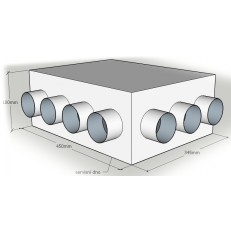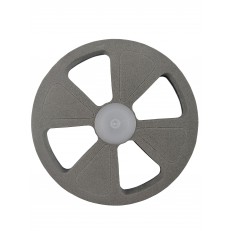Recuperator and recuperation efficiency
AIRMEN ADVISE …
HOW TO CHOOSE A RECOVERY UNIT - RECOVERYER and RECOVERY EFFICIENCY
What is recovery:
Simply put, in winter, when you open a window, heat flies out of the house. During recuperation, the outgoing air (from the bathroom, kitchen, toilet, etc.) transfers its energy=heat to the outside air in the so-called recuperation exchanger. The heat is transferred through the heat exchange surface (plastic/aluminum) without the two air streams physically meeting. Clean outdoor air is filtered from dust, pollen, etc. in the unit, heated in the recuperator and continues into the occupied rooms (bedroom, children's room, living room, study, etc.). In the summer, the recuperator works on the same principle, but it does not protect the heat, but the cold in your interior.
Recovery efficiency:
It is an important value when choosing a unit, but not decisive. Manufacturers state this value under standardized conditions (exterior -5 °C, interior +20 °C). If condensation occurs during these measurements, the efficiency reaches up to 97% in some units. In real operation, however, consider an average efficiency of about 15% lower than the value given by the manufacturer. There are not many recuperator manufacturers in the world, most of the units for family houses sold in the Czech Republic have recuperators from several manufacturers. An interesting fact is that two big brands equip their units in the Czech Republic with their own Czech recuperators. According to our experience, the recuperator material (aluminium/plastic) does not play any significant role in family houses.
Types of recuperators (recuperation exchangers):
A) Countercurrent plate recuperator
1) Cross-type (efficiency around 60%, no problems with anti-freeze protection, nowadays hardly occurs in recuperation units for family houses). Some Nordic manufacturers, for example, use two in a row.
2) Diagonal (efficiency around 90%, frost protection necessary for lower temperatures, most used type of recuperator - unit manufacturers Elektrodesign, Atrea, 2VV, ...). Several manufacturers allow you to change to enthalpy for the winter.
B) Counterflow tubular
(efficiency 50-70%, works well for heat transfer between water streams, but for central air handling units it is too large and thus loses its attractiveness, although its pressure drops are lower and it does not have problems with condensation and freezing, its biggest use is currently in local recuperation units in the wall - e.g. ECO ROOM, where it is often called a "straw")
C) Rotary (regenerative) recuperator
(efficiency around 80%, units without the need for condensate drainage , one extra motor for turning the recuperator, also transfers part of the moisture with the heat, this type of recuperator is mainly represented by Systemair and Domekt units )
D) Alternating recuperator
(the efficiency varies, usually 70-80%, the direction of air flow through one channel alternates at individual intervals, the recuperator/accumulator thus charges for a while and then discharges, the Jablotron FUTURA units are equipped with a similar recuperator with a stated higher efficiency, which also use the system for reverse moisture gain)
Enthalpy exchanger
produced mostly in the shape of a counter-current diagonal, like the other above-mentioned recuperators, it prevents the direct contact of the exhaust air with the supplied fresh air, but at the same time it allows a part of the water vapor to pass back into the supplied fresh air. Suitable for houses where there is a risk of drying out (typically wooden construction with little moisture production). When choosing the type of recuperator, carefully inquire with the manufacturer about the type of membrane, the warranty on the recuperator and its price. This is still a fairly new solution, the durability and hygiene of this solution is still a debated question).
If you are still not sure which one is the best for your home, you are not alone! Simply put, each of the recuperators has its pros and cons. That's why we offer you as many types as possible so that everyone can choose.
If you need a personal consultation, call or write!
Last edit: 18/08/2020














